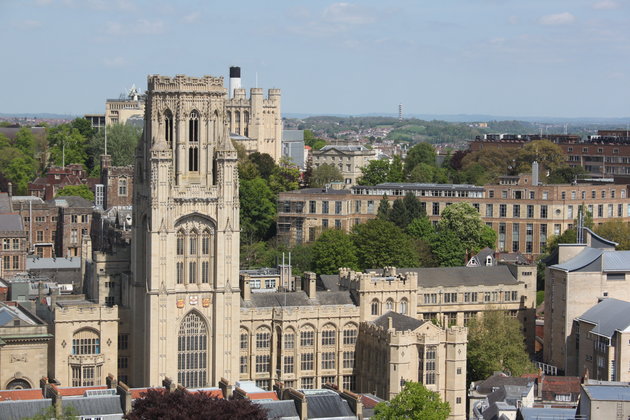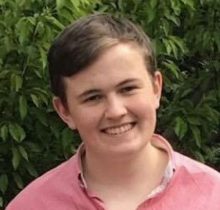 When 20-year-old maths student James Thomson (left) was found hanged at his house in Bristol on October 25th last year, it was reported that he was he was the sixth student from the University of Bristol (top) to have died a self-inflicted death within the space of a year.
When 20-year-old maths student James Thomson (left) was found hanged at his house in Bristol on October 25th last year, it was reported that he was he was the sixth student from the University of Bristol (top) to have died a self-inflicted death within the space of a year.
Yesterday’s inquest heard that James first went to the University in September 2015. He found it difficult to integrate at his hall of residence and, according to his parents, going from a class size of 15 at school to lecture halls of more than 100 students affected him. His attendance declined and in February 2016 he failed exams, after which it was suggested that he should take a year out to complete his modules.
James went home to Northampton and expressed his determination to do well and resume his course. Over Christmas, his parents were shocked to find antidepressants in his room, and he admitted that he had been on them for a while.
James went on to pass his exams and he resumed his studies in September 2016. The following month, he attended the Students’ Health Service (SHS). He had regular check-ups and his medication increased in dosage in January 2017.
James’s personal tutor told the court in a statement that he did not know that James was suffering from low moods and depression.
In his conclusion, coroner Peter Harrowing ruled that James’s death was suicide. He said: “His parents are understandably shocked at the sad loss of their son, and raised concerns about whether anything else could have been done.” He stated, however, that he was assured Bristol University had everything in place to prevent further deaths. Referring to the other students who had died during the past year, he said that their deaths were “not linked”.
The first of the six students to die was first-year student Daniel Green (18) who, in October 2016, was found hanged in his room at a hall of residence. Details of Daniel’s involvement with the SHS during the few weeks he was at the university were not reported, except for the statement that “University authorities had said that Daniel had previously asked about accessing counselling.”
It is possible that Daniel may have been medicated while awaiting an appointment with a counsellor. Coroner Myfanwy Buckeridge delivered a narrative conclusion, saying that Daniel “took his own life but the question of intent is inconclusive.”
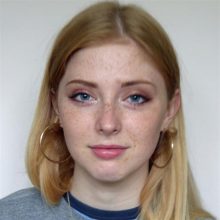 Also in October 2016, first-year philosophy student 19-year-old Miranda Williams (right) died in hospital of an overdose of paracetamol, after students in her hall of residence found her semi-conscious.
Also in October 2016, first-year philosophy student 19-year-old Miranda Williams (right) died in hospital of an overdose of paracetamol, after students in her hall of residence found her semi-conscious.
Her inquest in June 2017 heard that while she had been at school in Sussex, she was “popular and had a wonderful circle of friends.” However, Miranda found it difficult to make new friends in Bristol, so she “sought advice from a Student Health Centre and was prescribed an antidepressant.” Dr Harrowing delivered a verdict of suicide.
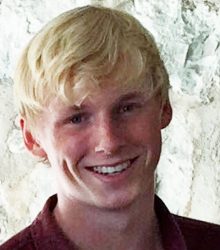 Kim Long (left), another first-year student, was found asphyxiated in his room at a hall of residence in November. He had left a note for his parents, who told an inquest in February that the 18-year-old had never tried to self-harm, and showed no signs of depression or hopelessness. A representative from the SHS confirmed that Kim had not sought any support.
Kim Long (left), another first-year student, was found asphyxiated in his room at a hall of residence in November. He had left a note for his parents, who told an inquest in February that the 18-year-old had never tried to self-harm, and showed no signs of depression or hopelessness. A representative from the SHS confirmed that Kim had not sought any support.
Although Kim had not taken any prescribed medication, an amount of Ketamine was found in his system. Dr Harrowing delivered a verdict of suicide.
 In January 2017, the body of Lara Nosiru (right), a 23-year-old final-year neuroscience student, was found in Avon Gorge. She had fallen from Clifton Suspension Bridge. Her inquest in September heard that Lara had suffered from depression for four years, and took an overdose of antidepressants the night before her death. The next morning, she took an unnamed Class A drug before taking a taxi to the bridge.
In January 2017, the body of Lara Nosiru (right), a 23-year-old final-year neuroscience student, was found in Avon Gorge. She had fallen from Clifton Suspension Bridge. Her inquest in September heard that Lara had suffered from depression for four years, and took an overdose of antidepressants the night before her death. The next morning, she took an unnamed Class A drug before taking a taxi to the bridge.
Dr Harrowing said that he couldn’t be sure beyond reasonable doubt that she had the mental intention to take her life that day, and concluded: “She took her own life whilst under the influence of drugs.”
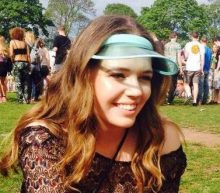 Third-year student Elsa Scaburri (left), who was 21, was studying modern languages. In January 2017, she returned home prematurely from a placement in Italy, where she felt “worthless”. She was diagnosed with clinical depression and was given therapy as well as antidepressants.
Third-year student Elsa Scaburri (left), who was 21, was studying modern languages. In January 2017, she returned home prematurely from a placement in Italy, where she felt “worthless”. She was diagnosed with clinical depression and was given therapy as well as antidepressants.
Doctors said they had “no concerns” about her. However, in March 2017, Elsa hanged herself in a barn near her home in Wiltshire. At her inquest in September, coroner Ian Singleton’s verdict was suicide.
Of these six students who took their lives within the space of a year, it would seem that Kim was the only student who was definitely not on antidepressants. He had, however, taken Ketamine.
Although it is not certain that Daniel was taking antidepressants, the fact that he had asked the SHS about counselling renders the possibility highly likely.
The other four students had all been prescribed antidepressants before their deaths. Miranda, Lara and James all died in Bristol while attending the University, whereas Elsa was treated and died at her family home.
In the USA, it is probable that not one of these students would not have been prescribed antidepressants, as restrictions similar to those that NICE recommends for anybody under the age of 18 are extended by the FDA to anybody under the age of 25.
Even so, NICE Guidelines for adults state that, because of the heightened risk of suicide, antidepressants should be prescribed only for moderate to severe depression. In which case, the patient would not be deemed well enough to be attending university and, in most cases, should be in the care of parents.
Universities have a duty of care towards their students. To prescribe antidepressants, recklessly and inappropriately, in contravention of NICE Guidelines, makes it impossible to carry out that duty of care.
Update (Feb 2018)
 About 5 km to the North-East of the Bristol University campus, the town has a second university. The University of the West of England (UWE Bristol) has its own Health Centre on the Campus.
About 5 km to the North-East of the Bristol University campus, the town has a second university. The University of the West of England (UWE Bristol) has its own Health Centre on the Campus.
In May last year, 19-year-old Sam Symons (left), a first-year law student, was found hanged in his room, after friends raised the alarm when he had not been seen for a while. At his inquest in July, it was reported that “therapeutic levels” of two unnamed “sedatives” had been found in his system; it was believed that these were prescribed to Sam for anxiety.
 Less than 3 weeks before Sam’s death, 21-year-old Raven Hunt, (right), a third-year sociology student at UWE, was found hanged. Her inquest in July was not reported in the media, but came to light earlier this week when her parents claimed that authorities tried to “cover up” their daughter’s death.
Less than 3 weeks before Sam’s death, 21-year-old Raven Hunt, (right), a third-year sociology student at UWE, was found hanged. Her inquest in July was not reported in the media, but came to light earlier this week when her parents claimed that authorities tried to “cover up” their daughter’s death.
Raven had been taking antidepressants since she was 15, after a diagnosis of anxiety and depression while preparing for her GCSE exams. Raven’s parents learned that, about eight weeks before her death, she had started using Xanax (a benzodiazepine, aka Alprazolam), given to her by a friend, to cope with anxiety issues ahead of her final exams. But two weeks before her death, she decided to come off the drug but was suffering from its severe withdrawal symptoms. She broke up with her boyfriend, and was drinking excessive amounts of alcohol. When she approached a doctor, she was told treatment could only start weeks later. She had gone on to complete her degree but, less than a week before she died, Raven had seen a psychiatric nurse and talked about poor motivation and concentration. The university declined to send a representative to her inquest.
Update (May 27 2018):
 Yesterday’s Guardian contained an article by education correspondent Sally Weale (left) beneath the headline “Bristol University faces growing anger after student suicides”.
Yesterday’s Guardian contained an article by education correspondent Sally Weale (left) beneath the headline “Bristol University faces growing anger after student suicides”.
Sally reported that: “Students who have felt helpless in the face of each reported death are now mobilising. About 400-500 people took part in a march in the city on Friday to demand changes to mental health services at the university.
“Meanwhile, staff, who are doing their best to support students, feel ‘besieged’ and ‘hurt’ by criticism of university services. Some members of the pastoral team are on antidepressants themselves.”
Further on in the article, Sally reported that: “a second-year English student, who suffers from anxiety, said that when she sought help she was encouraged to take antidepressants. ‘I had less than a 10-minute assessment and they decided they wanted to give me pills. But I don’t feel like it’s the right thing for me.’”
NICE does not recommend prescribing antidepressants for anxiety because “the risk-benefit ratio is poor”.
Update (July 25 2018)
Yesterday’s BristolLive reported on the inquest of Justin Cheng, a 24-year-old law student at Bristol University. Justin was found dead in a hired car on January 12th this year, due to carbon monoxide toxicity.
 The inquest heard a statement from a GP at the Student Health Service. Dr Tom Reehal (left) told the court that he had first become aware of Justin’s problems in June last year. He had asked for increased dosage of medication and sleeping pills, and had expressed thoughts of suicide.
The inquest heard a statement from a GP at the Student Health Service. Dr Tom Reehal (left) told the court that he had first become aware of Justin’s problems in June last year. He had asked for increased dosage of medication and sleeping pills, and had expressed thoughts of suicide.
Recording a conclusion of suicide, coroner Peter Harrowing said: “Despite all the intervention and help by all at the university, he was found deceased.”
Related Articles:
Students, Anxiety and Antidepressants
